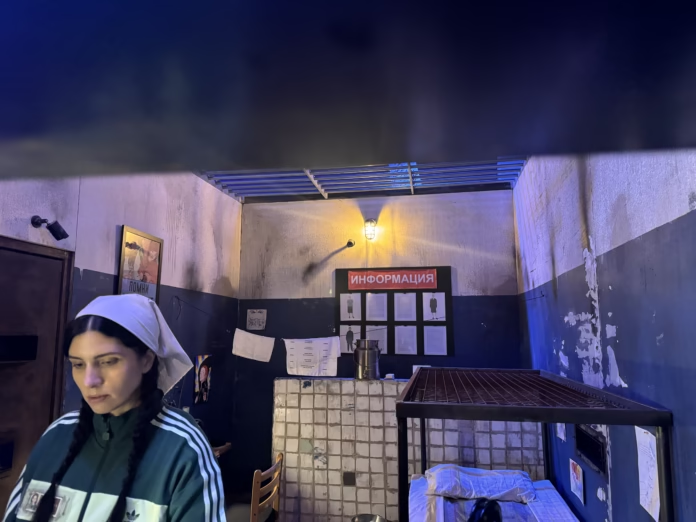Nadya Tolokonnikova revisits her imprisonment for protests with Pussy Riot, and finds herself again in a “Police State”
By Evelyn McDonnell
In downtown LA, the artist Nadya Tolokonnikova is currently performing an art piece that is both a time capsule and a prophecy. “Police State” opened June 5 just blocks from the streets that would a day later become a battleground, with government forces intent on ripping workers from their jobs, families, and homes; incarcerating them without due process; and then assaulting the good citizens who attempted to protect their neighbors and exercise their right to assembly and free speech. The clampdown is an experience Tolokonnikova knows intimately. In the heart of the giant WAREHOUSE space at the MOCA Geffen Contemporary stands a metal jail. It is modeled after the cell in which she spent almost two years after her group Pussy Riot protested Vladimir Putin’s theocratic regime.
Tolokonnikova is spending all day in this 10’x16’ room. On the wall of her cage hang artworks from political prisoners in Russia, Belarus, and the US. She live-mixes her voice, her heartbeat, prayers, shouted commands from harsh male voices, and other ominous sounds in volumes that rise and fall. You can watch her through small windows as she mixes, sews, eats, urinates. In the warehouse, banners emblazoned “Punk’s not dead” in Arabic-looking cursive twist and turn in wind created by fans. Pieces from her Icon series hang on the wall, fashioned from bed sheets made by American and Belarusian prisoners. Gumball dispensers are labeled with the names of poisons known to be used against Putin’s enemies.
The durational performance is intense and terrifying, all the more so because it is based in Tolokonnikova’s lived history and references the real incarcerations of so many others. If you have any experience of having your own or a loved one’s liberty constrained – or if you just exercise your human capacity for empathy – “Police State” can be hard to endure. That’s the point.
I would imagine it’s intensely triggering for Nadya. She has said that she is doing it as a form of therapy to confront the continued trauma of her arrest, trial, and imprisonment. But it is also a warning to its viewers.
On my way home from witnessing “Police State,” I drove through LA’s garment district, thinking about all the people who work there, their industry and their struggles. Little did I know that the next day, ICE would swoop in with their military gear and steal away 45 human beings, including David Huerta, the president of the Service Employees International Union, California. Angelenos took to the streets, attempting to stop the detentions and drive the national good squad away. In the ensuing mayhem, now on day four, ICE officers, the Los Angeles Police Department, and finally the National Guard fired tear gas and “less-lethal” ammunition at people exercising their rights to free speech and assembly, including foreign journalists.
Talk about a Police State.
Ironically, the MOCA Geffen itself had to close its doors due to the police violence outside. Tolokonnikova is still enclosing herself in her cell, continuing her performance, now “blasting the live audio of the protests at the empty museum,” she posted on her Instagram account. “Police State,” the installation, continues until Sunday, when a conversation with Nadya Tolokonnikova and others is scheduled, followed by a concert with Pussy Riot Siberia. That is, the talk and show will happen if the real Police State happening outside her cell and the museum allows.




[…] Read my review for Random Lengths News: https://www.randomlengthsnews.com/archives/2025/06/10/an-art-piece-becomes-real-life/71034 […]